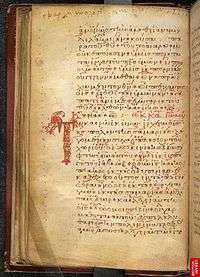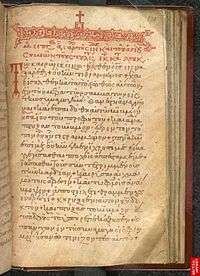Lectionary 187
|
Folio 170, the decorated head-piece at the top | |
| Name | Arundel 547 |
|---|---|
| Text | Evangelistarion † |
| Date | 13th century |
| Script | Greek |
| Now at | British Library |
| Size | 23.7 cm by 15.2 cm |
Lectionary 187, designated by siglum ℓ 187 (in the Gregory-Aland numbering) is a Greek manuscript of the New Testament, on parchment leaves. Scrivener labelled it by 256e. Palaeographically it has been assigned to the 13th century. The manuscript is lacunose. It forms part of the British Library Arundel Manuscripts. The codex is in the British Library as MS Arundel 536.[1][2]
Description

The codex contains lessons from the Gospels of John, Matthew, Luke lectionary (Evangelistarium) and the Epistles.[3][4] The manuscript has lacuna at the beginning (three leaves). These three leaves were supplemented by a later hand on paper (probably in the 15th century).[4] They are unfoliated modern paper flyleaves, numbered as I-III leaves. The leaves 172-173 were supplemented by a later hand on parchment.[5]
It is written in Greek minuscule letters, on 217 parchment leaves (23.7 cm by 15.2 cm). The writing is in one column per page, 23-27 lines per page, in black ink.[1] It contains musical notes in red[4] and decorated head-pieces in red.[5] The initial letters are large, written on the margin, in red and yellow, or red, black, and yellow. The decorations are zoomorphic (birds, fishes, snake) or anthropomorphic (hands).[5]
The lessons of the codex were read from Easter to Pentecost in the weekdays and on Saturday.[1]
History
The area of origin is the eastern Mediterranean.[5] Usually it is dated to the 13th century (Scrivener, Gregory, Aland),[1][2][4] sometimes to the 12th century.[5]
The manuscript was presented by Henry Howard, 6th Duke of Norfolk, to the "Royal Society" in London in 1667. It was transferred to the British Museum with 549 other Arundel manuscripts in 1831.[5] In 1897 the manuscript was rebound.[5]
It was added to the list of New Testament manuscripts by Scrivener (256)[3] and Gregory (187).[4]
The manuscript is sporadically cited in the critical editions of the Greek New Testament (UBS3).[6]
The manuscript was examined by Bloomfield.[4] Gregory saw the manuscript in the 1883.[4] The text of the manuscript is not cited in modern editions of the Novum Testamentum Graece.[7]
See also
Notes and references
- 1 2 3 4 Aland, Kurt; M. Welte; B. Köster; K. Junack (1994). Kurzgefasste Liste der griechischen Handschriften des Neues Testaments. Berlin, New York: Walter de Gruyter. p. 230. ISBN 3-11-011986-2.
- 1 2 "Liste Handschriften". Münster: Institute for New Testament Textual Research. Retrieved 16 November 2010.
- 1 2 Scrivener, Frederick Henry Ambrose; Edward Miller (1894). A Plain Introduction to the Criticism of the New Testament. 1 (4th ed.). London: George Bell & Sons. p. 345.
- 1 2 3 4 5 6 7 Gregory, Caspar René (1900). Textkritik des Neuen Testaments. 1. Leipzig: J.C. Hinrichs. p. 402.
- 1 2 3 4 5 6 7 Arundel 536
- ↑ The Greek New Testament, ed. K. Aland, A. Black, C. M. Martini, B. M. Metzger, and A. Wikgren, in cooperation with INTF, United Bible Societies, 3rd edition, (Stuttgart 1983), pp. XXVIII, XXX.
- ↑ The Greek New Testament, ed. K. Aland, A. Black, C. M. Martini, B. M. Metzger, and A. Wikgren, in cooperation with INTF, United Bible Societies, 3rd edition, (Stuttgart 1983), p. XXVIII
Bibliography
- Edward Bernard, Catalogi librorum manuscriptorum Angliae et Hiberniae, 3 vols (Oxford: Sheldonian, 1697), III, no. 3442.
- Catalogue of Manuscripts in The British Museum, New Series, 1 vol. in 2 parts (London: The British Museum, 1834–1840), I, part I: The Arundel Manuscripts, pp. 163–64.
- Summary Catalogue of Greek Manuscripts (London: British Library, 1999- ), I, 18-19.
External links
- Lectionary 547 at the British Library
